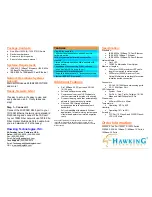
FX826ES
Get Connected With Hawking
•
Two 10/100 Ports & Six 100Base-FX SC Ports
•
Full and Half Duplex capability on every port.
•
Designed in compliance with 10Base-T, IEEE
802.3u, 100Base-TX and 100Base-FX standards.
•
Comprehensive array of LED indicators that
communicate the status of the switch and
troubleshooting information.
•
Dynamic learning mode that automatically adjusts
to the network configuration.
•
Runt and CRC filtering eliminates erroneous
packets to optimize network bandwidth.
•
19” Rack Mount
•
110/220V Auto-sense Internal Power Supply
Extended Your Network Distance and
Security
The Hawking FX826ES Fiber Switch is a ideal
solution for connecting a fiber optical network to
regular 10Base-T Ethernet or 100Base-TX Fast
Ethernet network to extend the network distance to
2000 meters (6560 ft.). It is great for intra-building
connection or the distance beyond 100 meters
(328ft). It transmits up to 200Mbps speed.
FX826ES allows you to connect up to six fiber optical
segments and two 10/100M segments.
Switching Technology
Switching is a cost-effective way of increasing the
total network capacity available to users on a local
area network. A switch increases capacity and
decreases network loading by dividing a local area
network into different
segments
, which don’t compete
with each other for network transmission capacity.
The switch acts as a high-speed selective bridge
between the individual segments. The switch,
without interfering with any other segments,
automatically forwards traffic that needs to go from
one segment to another. By doing this the total
network capacity is multiplied, while still maintaining
the same network cabling and adapter cards.
For Fast Ethernet networks, a switch is an effective
way of eliminating problems of chaining hubs beyond
the “two-repeater limit.” A switch can be used to split
parts of the network into different collision domains,
making it possible to expand your Fast Ethernet
network beyond the 205-meter network diameter
limit for 100BASE-TX networks. Switches supporting
both traditional 10Mbps Ethernet and 100Mbps Fast
Ethernet are also ideal for bridging between existing
10Mbps networks and new 100Mbps networks.




















